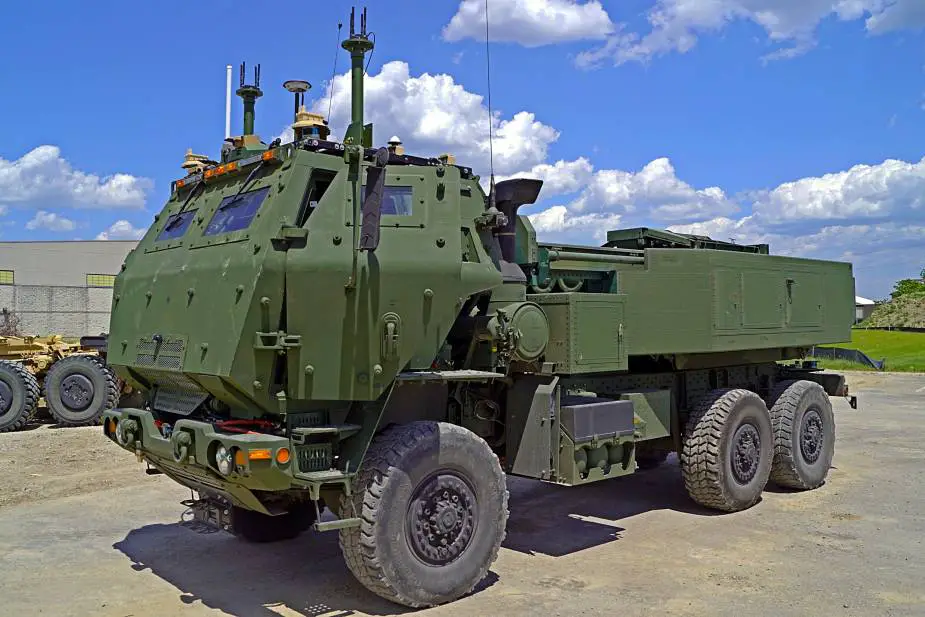Testing of US Army first autonomous vehicle speeds ahead
Imagine the possibilities of a self-driving vehicle on the battlefield. Engineers at the U.S. Army Combat Capabilities Development Command Aviation & Missile Center, or AvMC, don’t have to imagine it: they are building it. The Autonomous Multi-Domain Launcher takes a High Mobility Artillery Rocket System — or HIMARS — and modifies it with hardware and software to be controlled remotely and driven autonomously. Katie Davis Skelley, U.S. DEVCOM Aviation & Missile Center Public Affairs, reports.
Follow Army Recognition on Google News at this link

The Autonomous Multi-Domain Launcher participates in the U.S. Army's System Integration Event 2 in 2022 (Picture source: U.S. Army )
“[The Autonomous Multi-Domain Launcher] represents a significant and exciting modernization improvement for the Army,” said Christi Dolbeer, director of DEVCOM Aviation & Missile Center’s Technology Development Directorate. “Adding autonomy to drive mobile launchers and increasing the firing power of those launchers represents a powerful combination. I am very proud of the DEVCOM AvMC and DEVCOM Ground Vehicle Systems Center teams working together to give Soldiers even greater capabilities.”
While it resembles the self-driving cars in the news, the Autonomous Multi-Domain Launcher — or AML — will have capabilities that those vehicles will never possess — but also challenges. Regular autonomous autos operate on established roadways, they aren’t navigating sometimes treacherous terrain. They also aren’t being fired upon by enemy combatants. Then there is the matter of size.
“We are talking about putting a 36,000-pound vehicle in an area where there will be humans running around,” said Lucas Hunter, AML project manager for AvMC. “Tesla and other companies are working on vehicles that can sense cars in front of them and behind them; they have these nice stripes on the road that tell it, ‘I am getting out of my lane.’ Well, we are driving through open country, we don’t have stripes — we have holes, we have cliffs.”
AML in its current incarnation will look notably different than the final system as the existing cab will eventually be eliminated from the vehicle. Later iterations will also boast a new launcher and increased firing power.
AML was conceptualized as a tool to increase mass fires and “thicken the force,” but what exactly does that translate to in theater? “AML applies a wingman concept to the Soldiers we already have on the battlefield,” Hunter said. “That spreads out capabilities. So more targets have to be addressed by the enemy. At the same time, it increases the number of rounds that our Soldiers have available which keeps them in the fight longer. With HIMARS, once they fire their six rounds, they have to reload. If you add 12 more, now they are able to support frontline troops three times as long.”
How this new capability will be utilized is currently being explored by the Fires Center of Excellence and the Strategic and Operational Rockets and Missiles Office. Concept testing was conducted in 2021 at Fort Sill, Oklahoma, to demonstrate how the wingman concept might look, emulating a mission with the Precision Strike Missile — the missile being part of the Army’s Long-Range Precision Fire cross-functional initiative and also in the AvMC portfolio.
For Hunter, AML marks not just a landmark paradigm shift for Army battlefield technology, but for the world of robotics itself. With the strides already made in breaking the manual chain and developing the robotic applique kit, it is easy to forget that AML has only been in existence since February 2020. “There are all kinds of situational awareness challenges that the robotics industry is just now starting to look at,” Hunter said. “AML, which will be called HIMARS Increment 2, has to be able to travel wherever it is told to travel. It has to be able to tell, ‘Hey, there is a cliff right here.’ It has to be able to recognize whatever terrain it is on. “This is a career field in robotics — how to enhance that situation awareness and do so in passive manners. We need sensors that collect situational awareness data without emitting detectable energy like light or sound. Because you don’t want this to light up like a Christmas tree when the enemy is looking.”
━━━━━━━━━━━━
The DEVCOM Aviation & Missile Center, headquartered at Redstone Arsenal, Alabama, is the Army’s research and development focal point for advanced technology in aviation and missile systems. It is part of the U.S. Army Combat Capabilities Development Command (DEVCOM), a major subordinate command of the U.S. Army Futures Command. AvMC is responsible for delivering collaborative and innovative aviation and missile capabilities for responsive and cost-effective research, development and life cycle engineering solutions, as required by the Army’s strategic priorities and support to its Cross-Functional Teams.




























